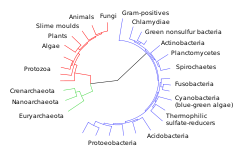- Modularity (biology)
-
For other uses of "Modularity", see Modularity (disambiguation).
Many organisms consist of modules, both anatomically and in their metabolism. Anatomical modules are usually segments or organs. When we look at illustrations of metabolic reactions, we find that they, too, are modular: we can clearly identify, for instance, the citric acid cycle as a complex network that has only a few interfaces with other such modules. This principle holds true at various scales: we can identify smaller modules within such larger networks that are similarly self-contained. We say that metabolic modularity is scale-free.
In addition to showing scalefree and small world properties, biological networks appear to exhibit modularity in topological structure. In the field of network biology, the definition of nodes and edges in a given network depends on the type of network examined. For example, in a protein interaction network, nodes correspond with individual proteins and edges represent the interactions between them (either through direct physical interaction, or compound-mediated). Metabolic networks, on the other hand, contain metabolite nodes and edges that represent the specific enzymes that connect them (in catalyzing biochemical reactions). As with any type of network, modularity in biological networks allows sub-groups of nodes and edges to function in a semi-autonomous fashion.
The concept of modularity resurfaces at the scale of organs and developmental units. Why are there distinct cell types organised into spatial aggregations (organs), and what are the benefits of having a segmented body plan, containing different modules (for instance, thoracic and abdominal segments in an arthropod) and where one of the possible differences between species is in the number of each type of module they possess?
Interestingly, this property has led researchers to suggest that modularity imparts a certain degree of evolvability to a system by allowing specific features (i.e. network sub-groups) to undergo changes without substantially altering the functionality of the entire system. Essentially, each module is free to evolve within, so long as the interfaces between modules remain consistent. This would suggest that the metabolic pathways at the edges between modules are more constrained. It is thought that there exists an optimal degree of modularity for each given organism.
External links
- Homologues, Natural Kinds, and the Evolution of Modularity
- Modules: Key Pieces in the Integration of Developmental and Evolutionary Biology
- Modularity in Animal Development and Evolution: Elements of a Conceptual Framework for EvoDevo
Part of a series on Evolutionary Biology  Key TopicsHistory of TheoryNatural HistorySocial ImplicationsFields & ApplicationsApplications of evolution
Key TopicsHistory of TheoryNatural HistorySocial ImplicationsFields & ApplicationsApplications of evolution
Artificial selection
Bioinformatics
Evolutionary anthropology
Evolutionary computation
Evolutionary dynamics
Experimental evolution
Ecological genetics
Evolutionary neuroscience
Evolutionary physiology
Evolutionary psychology
Phylogenetics
SystematicsEvolutionary Biology Portal
Category • Related topics • BookThe development of phenotype Key concepts Genetic architecture Dominance relationship · Epistasis · Polygenic inheritance · Pleiotropy · Plasticity · Canalisation · Fitness landscape · Transgressive phenotypeNon-genetic influences Developmental architecture Evolution of genetic systems Influential figures Debates Categories:- Biology terminology
Wikimedia Foundation. 2010.
